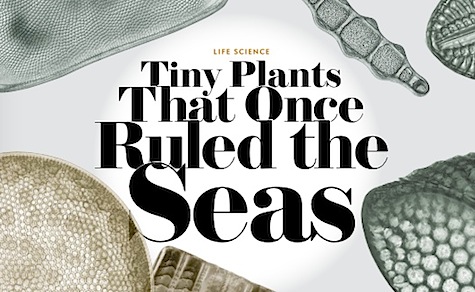People tend to pay attention to big animals when they go to the zoo or museum. They go to see the gorillas, or the tigers, or the dinosaur bones. I get it; dinosaurs are awesome. The problem is that charismatic megafauna tell only a very narrow story about evolution and biology. Again, admittedly an awesome one—dinosaurs!—but there are plenty of other neat stories that smaller critters can tell. The lives of rodents, or the humble honey bee, of fungi who infect ants and drive them to literal lunacy. Focusing on all those oddball forms of life, big or small, can lead people to overlook the unsung heroes of the ecosystem. June’s Scientific American doesn’t fall into that trap, with its article on the “Tiny Plants That Once Ruled the Seas” being a bit of a love letter to…plankton. In particular, that the rise of modern sea life, in the wake of the Permian-Triassic Extinction Event, can be traced to phytoplankton, which literally fueled the bloom of diversity in the Mesozoic (that’s dinosaur times!) and Cenozoic (that’s now). In doing so, the authors Ronald Martin and Antoinetta Quigg also tie the rise of phytoplankton into the threat of climate change.
I don’t have to patronize the people reading this. It is easy to see how a flourishing food source would give rise to other forms of life. After all, that is the basis of the food chain, the food web, whatever you want to call it. Phytoplankton is eaten by…well, more tiny plankton, zooplankton, then zoom, on up the food chain. Not only does more food mean more life, but it means more interesting life; you can’t have your big critters with specialized biology without plenty of calories to go around. During the Paleozoic (the authors of the piece speculate that if you hopped in a time machine to the Paleozoic, you’d think you’d gone to another planet entirely, and in some ways you’d be right) green algal phytoplankton ruled the sea. This is the boring stuff; just dense and nutrient poor, keeping marine life locked into slower metabolic rates. It was the rise of red phytoplankton, rich delicious stuff, that let crazy predators evolve, up at the top of the “circle of life,” along with all kinds of other weird ocean life.
What caused the switch from green to red phytoplankton? Micronutrients. That is, well…fertilizer. Photosynthesis is mostly using the carbon from the atmosphere and the hydrogen and oxygen from water to build life, but just as animal life require vitamins, autotrophic life needs other things. In particular, green phytoplankton wants iron, zinc and copper, and thrive under lower oxygen levels, while higher oxygen levels help things like manganese, cadmium and cobalt dissolve in the oceans—the stuff that red phytoplankton crave. Macronutrients—even more highly in demand—like phosphorus also started pouring into the seas, as wetter weather patterns and plant roots broke up the soil and rotting leaf litter from flowering plants ran off into the sea, as did the rise of mountains as the continents clashed into Pangaea.
What does this all have to do with today and anthropogenic climate change? Well, for one thing, carbon emissions causes both global warming and the acidification of the oceans. In other words, the conditions of the sea are becoming much more like the Paleozoic, returning to the conditions where the less diverse green phytoplankton thrived, rather than the red. Coccolithophores, plankton with calcium carbonate exoskeletons, could soak up some of the carbon, and will in the deep sea, but the rapid rate of acidification will kill them off in the shallows, stopping that absorption cycle. Not only that, but Coccolithophores produce chemicals that seed cloud formation; as they die off, the global warming problem with increase even further, with less clouds to bounce sunlight off the atmosphere. And remember how nutrient run-off helped the switch to red plankton? Well, runoff from human causes—deforestation and agricultural fertilizers mixing into a heady cocktail—are causing a frenzy of excessive growth, choking out the usual lifecycle and resulting in stagnation and decay. The ones that do thrive, like dinoflagelletes, create toxic blooms, which can poison the feeding grounds of migratory birds and fish. When things start going wrong at the base of the food chain, everything above it is in jeopardy.
So that is the deal with plankton: they might not be the most interesting things—though up close they look like alien spaceships and there are bioluminescent plankton, so maybe it is interesting, if you pay attention—but it allows the more interesting forms of live to evolve and thrive. They are a keystone to both evolutionary history and the current marine ecosystem; they’ve demonstrated their importance throughout the history of life, and we ignore those lessons at our peril.
Mordicai Knode’s favorite word is “bioluminescence,” and wants everyone to know that the enzyme that catalyzes the reaction is called “luciferase.” You can follow him on Tumblr and Twitter.











#PlanktonAtFour
And what about Sheldon J. Plankton, huh? How can you not love a Plankton whose filing cabinet is labeled “Evil Plans”?
2. Tehanu
Someone else brought that up, so let me say: I will never forgive SpongeBob for laughing at Korra when she fell!